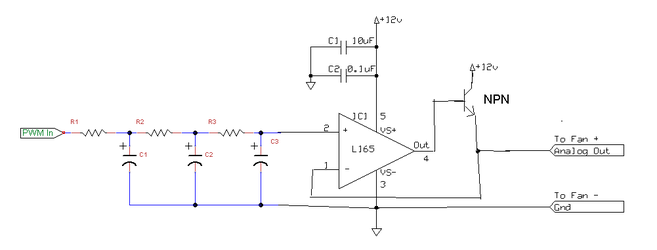So I imagine everyone in this forum who is interested in fan controllers has come across Bing's PWM controller for 4 pin fans.
My thought is that it would be great to have a small circuit that could be bolted on to the output of his controller to turn the 0-5V PWM signal into an average analog voltage between 0 and 12 volts (As opposed to a 0-12V PWM signal directly on the power rail of the fan) while still supplying enough power to drive a few fans (At least 20W, ideally well over 30W)
So idea #1 is to use a low pass filter on the PWM signal and a high power op amp to scale the voltage up to the right levels The one I'm using is 3A, although there are even higher power ones for more money if you need the extra juice. The one I used in this circuit is linked. It is $1.71 from digikey. (A 5amp alternative, although some extra wiring is required).
So without further ado, hopefully this one makes much more sense. I send the output of the low pass filter into the + terminal of the OP AMP, and then the - terminal is hooked up as a non-inverting OP AMP with a gain of ~2.4, which is also 12/5.

Although according to Bing, there may be an issue with not being able to reach the full 12V with this circuit, so I'll also be looking into additional options.
My thought is that it would be great to have a small circuit that could be bolted on to the output of his controller to turn the 0-5V PWM signal into an average analog voltage between 0 and 12 volts (As opposed to a 0-12V PWM signal directly on the power rail of the fan) while still supplying enough power to drive a few fans (At least 20W, ideally well over 30W)
So idea #1 is to use a low pass filter on the PWM signal and a high power op amp to scale the voltage up to the right levels The one I'm using is 3A, although there are even higher power ones for more money if you need the extra juice. The one I used in this circuit is linked. It is $1.71 from digikey. (A 5amp alternative, although some extra wiring is required).
So without further ado, hopefully this one makes much more sense. I send the output of the low pass filter into the + terminal of the OP AMP, and then the - terminal is hooked up as a non-inverting OP AMP with a gain of ~2.4, which is also 12/5.

Although according to Bing, there may be an issue with not being able to reach the full 12V with this circuit, so I'll also be looking into additional options.




